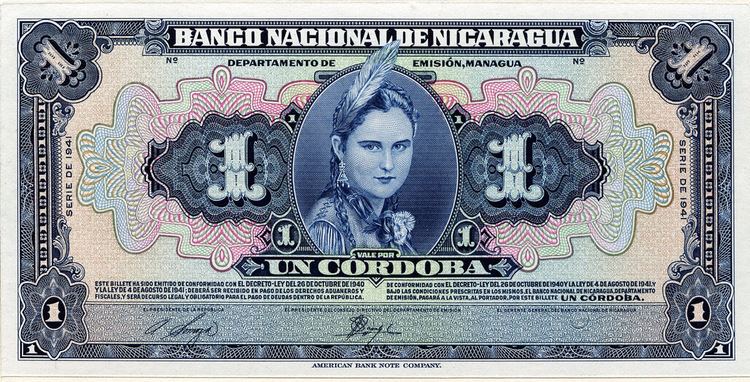Code NIO Symbol C$ | ||
 | ||
Banknotes C$10, C$20, C$50, C$100, C$200, C$500, C$1,000 Coins 5, 10, 25, 50 centavos, C$1, C$5, C$10 | ||
The córdoba ([ˈkordoβa], sign: C$; code: NIO) is the currency of Nicaragua. It is divided into 100 centavos.
Contents
Exchange rate
Since 1991, the Central Bank of Nicaragua has used a crawling peg scheme, devaluing the córdoba against the United States dollar by 5% per annum.
Historical exchange rates
History
The first córdoba was introduced on March 20, 1912. It replaced the peso moneda corriente at a rate of 12½ pesos m/c = 1 córdoba and the peso fuerte at par. It was initially nearly equal to the US dollar. It was named after the Conquistador Francisco Hernández de Córdoba.
On February 15, 1988, the 2nd córdoba was introduced. It was equal to 1,000 1st córdobas. On April 30, 1991 the third córdoba, also called the córdoba oro, was introduced, worth 5,000,000 2nd córdobas.
First córdoba
In 1912, coins were introduced in denominations of ½, 1, 5, 10, 25 and 50 centavos and 1 córdoba. The ½ and 1 centavo were minted in bronze, the 5 centavos in cupro-nickel and the higher denominations in silver. The 1 córdoba was only minted in 1912, whilst ½ centavo production ceased in 1937.
In 1939, cupro-nickel replaced silver on the 10, 25 and 50 centavos. In 1943, a single year issue of brass 1, 5, 10 & 25 centavos was made. These were the last 1 centavo coins. In 1972, cupro-nickel 1 córdoba coins were issued, followed, in 1974, by aluminium 5 and 10 centavos.
A new series of coins, featuring a portrait of Augusto César Sandino, was introduced in 1981, consisting of aluminum 5 and 10 centavos, nickel-clad steel 25 centavos and cupro-nickel 50 centavos, 1 and 5 córdobas. Nickel clad steel replaced cupro nickel between 1983 and 1984. In 1987, the final coins of the 1st córdoba were issued, featuring Sandino's characteristic hat. Aluminum 500 córdobas were issued.
25, 50 centavos and 1 córdoba coins minted in 1985 were mostly recalled and destroyed by the Central Bank. A few of the 1 córdoba were circulated as seen.
Second córdoba
No coins were issued for this currency.
Third córdoba (córdoba oro)
In 1985, coins dated 1987 but actually introduced with the re denomination, in denominations of 5, 10 and 25 centavos and aluminum-bronze 50 centavos, 1 and 5 Cordoba were issued.
In 1994, coins were issued in denominations of 5, 10, 25 and 50 centavos. All were minted in chrome-plated steel. In 1997, nickel-clad steel 50 centavos, 1 and 5 córdobas were introduced, followed by copper-plated steel 5 centavos & brass-plated steel 10 and 25 centavos in 2002 and brass-plated steel 10 córdobas in 2007.
All current coins have the coat of arms of the country on the obverse and the numeral of the denomination on the reverse.
